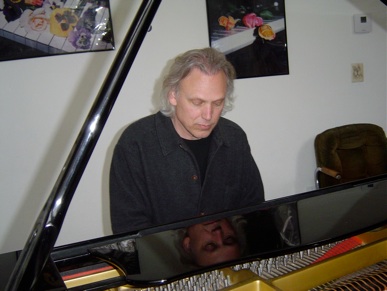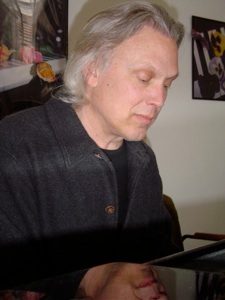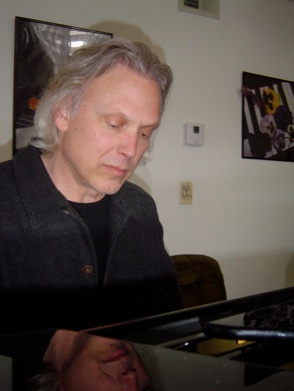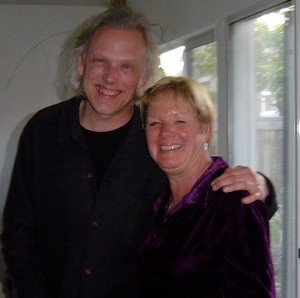With more than twenty recordings to his credit since his 1983 debut, “Heartsounds,” David Lanz has become one of the most loved and influential contemporary pianists out there. Lanz had the first new age single with “Behind the Waterfall” and was nominated for a Grammy Award in 2000 for “East of the Moon.” His gold record, "Cristofori's Dream," became the world's first #1 Billboard New Age/Adult Alternative album (#1 for 27 consecutive weeks). When we chatted by phone the end of January, we talked about many of the aspects of Lanz’s very impressive career and his then-upcoming tour of Korea with his collaborator on “Spirit Romance,” Gary Stroutsos, and the duo of Tingstad and Rumbel. They did a couple of Korean television shows and three concerts over the period of a week. I think you’ll enjoy this look at where Lanz has been and where he’s going!
KP: How many times have you toured Asia?
DL: This is my sixth trip to Korea. I made a couple of trips to Japan when Narada and Nipon Columbia had a relationship, but there doesn’t seem to be much of a relationship anymore with Narada and Asia other than Korea. Koreans seem to be really supportive of new age piano music. I was told that it’s a tradition for one of the children in a Korean family to play the piano, so the piano is always a part of the family. In Japan, they like the piano, but they tend to go more for the electronic side of music. Of course, that’s where most of the world’s electronics come from, and it’s worked its way into the culture. I get a lot of performance royalties from radio and television in Japan, so they still use the music, but it’s usually background, so it doesn’t necessarily mean that they’re looking to have the artists come and play concerts. Travelling’s great, but I kind of like hanging out at home. Been there, done that. Moving out of Seattle was sort of an attempt at semi-retirement. It hasn’t really worked, but I’m trying to slow down a little bit. Unfortunately, the imagination never slows down. I have fifty or sixty new songs started. I’m not going to use all of them, but I could easily do a couple of records.
KP: Are you going to continue with Narada?
DL: I really don’t know. We still have a pretty good relationship, but the record industry is changing dramatically. One example is that they don’t sign anybody anymore unless they really have a presence. Narada hasn’t signed any new artists, really, for years. They dropped their whole new age thing, and world music is waning. Smooth jazz is ever-present, so they lined up a bunch of well-known smooth jazz artists. They just aren’t taking any chances. Narada gave Stroutsos and I a nice advance for doing “Spirit Romance,” but they don’t want to spend any money once it’s released if the record doesn’t explode on its own. It just doesn’t happen that way.
KP: How can it if people don’t know about it?
DL: Exactly. The good part is the longevity of the music. Over time, it does find its way. Part of the problem is that people aren’t going into record stores. There’s nothing for labels to support, except in isolated cases. If you’ve got a record in Starbuck’s, then you’re in good shape.
KP: Isn’t it weird how that’s evolved?
DL: I think it started with the alternative markets. When new age music first came out, you’d go into a book store, a gift shop, or a store that sold things like incense and massage supplies, and new age music would be playing. It became kind of a phenomenon. From there, it branched into the mainstream for awhile, and it’s still fairly alive in the alternative markets. People who are looking for something relaxing would rather go into a relaxing environment to purchase it or just sit at home and download it at iTunes. The last three weeks, I’ve been in the top ten at iTunes with my “Best Of” collection, which was also a Narada release - another attempt on their part to create something out of the old.
KP: They’ve done a lot of that.
DL: Yeah. I think when people see “Best Of,”they decide to just get that album and be done with it. “Spirit Romance” was really high on the chart when it first came out, and then it disappeared completely. It’s back up now, so that’s the state of things.
KP: The “Spirit Romance” CD is quite different from your other albums. What inspired it?
DL: It was working with my friend, flautist Gary Stroutsos. We had talked about doing a full-blown recording project for about ten years. We did a few smaller projects together, and I arranged a couple of Native American songs on a record Narada put out called “I Am Walking.” Native American music was having its day, and this was a collection of mostly Native American artists. Gary is pretty well-known in that area because he helped start a Native American record company called Makoche. He’s kind of an ethnomusicologist. He had been a traditional flute player as a teenager and in his 20’s - mostly self-taught. His mother gave him a Native flute for a birthday present, and he really liked it. He started studying and trying to find music for it when he realized that it’s pretty-much a traditional instrument, and the music wasn’t written down or published. One thing lead to another, and he ended up in North Dakota where he befriended a number of Native American families. Gary lived with the Lakota tribe for awhile and learned their songs and the stories that go with them. Those credentials gave him some validity as opposed to being just another white guy ripping off the Indians. Gary had listened to R. Carlos Nakai’s and Peter Kater’s recordings and thought that we could do something that would be more satisfying. Gary and I talked about what we like and don’t like, and finally, after the politics cleared and my label commitments were over, the time seemed really right for us to do a record. Gary doesn’t like to write music - he’s more of an improv musician. He likes to sketch. The reason that the music is so different on this album is that we decided to not write the songs out. Usually when I work my music, I’m kind of meticulous, but I’ve also used improv my whole life. I’ve played a lot of jazz and freeform music - it’s just never made its way into my recordings. We decided to set up the recording gear and do some sketches, and then the music just kind of happened - more like a jazz record would.

KP: It’s gorgeous!
DL: It has its own kind of spirit. I was really taken by it when I first listened back to some of the tracks because we thought we were just sketching some ideas out, and we ended up making a record. Then we took it into the studio and I massaged things and tried to organize the information as much as possible without harming its delicate nature. The results are a really beautiful record that you can listen to more than once.
KP: Did you you actually record “Spirit Romance” in your house?
DL: We did. That was a surprise because we moved into this old house, and the piano just sounded amazing in my living room. We have these old growth fir floors through the whole house. There are slats of wood that are thirty or forty feet long with no breaks and no knots. The house was built back when there was a lot of wood. Bellingham is right on the coast and was a timber town, so they had easy access to really fine timber. We live in the older part of town, and feel lucky to have one of these homes. It’s just great to be in a place that has a lot of dark wood and a great feeling to it. Anyway, before we decided to record here, I had my brother come help me get set up for my general demo-making nights that I’m always doing. He started listening to the piano, and said, “Man, we’ve got to record something up here. It sounds great!” He and Stroutsos came up for a weekend, and we made kind of a makeshift studio so we could isolate ourselves enough to make the music manageable. We were all really taken with the sound, so everything just kind of fell into place and it ended up being a really fun project. We did all the piano and flute tracks here at the house, and then we took them to my brother’s studio in Seattle. We brought in percussionist Glen Velez from the Paul Winter Consort; bass player, Keith Lowe, who’s tremendous; and then Jon Serrie did some of the synthesizer stuff. We finished the overdubbing in my brother’s studio, and he did the final mixing there, too. It was a nice change because I’ve been doing these huge budget records. You don’t really need to spend so much money anymore to make a record. The technology has really leveled the playing field.
KP: As a recording artist, you’ve pretty much come full circle. You started out with a medium-sized label (Narada), went to a major label (Decca), did an independent release, and then went back to Narada. What’s next?
DL: Gary is starting his own label called Red Lightning Music, and he’s enlisting me for a few projects like creating spa music. We’re also getting ready to start a project with Jan Nickman, the filmmaker who did the visuals for “Natural States” and “Desert Vision.” Jan and I worked together for years at a company called Miramar. He did a lot of computer-animated projects and now he’s kind of come back full-circle as well. He lives in the southwest, and is working on a project called “Living Temples.” He really loves “Spirit Romance” so Gary and I are going to create the music for it. It will be a visual/musical project, so we’ll have an opportunity to get our music into the video market again, which is also coming back full-circle. We’ve had quite a bit of feedback from people who are successfully selling “Natural States” type products at some of the big retailers like Costco. At the moment, Jan is thinking of doing a whole series of “Living Temples,” the temple being a natural temple - we’re not going into churches or anything. He wants to do one in Hawaii, one in the northwest, the southwest, and possibly one in northern California - he’s actually done a lot of filming in the redwoods. It will be exciting! We’re going to try to create something like “Spirit Romance” in the sense of that open beauty kind of sound. It will probably be more compositional on my end because we’re going to be working with pictures that demand a certain amount of scoring. At this point, we’re not planning to get a label involved. Jan is going to produce the visuals with his own financing, and we’re thinking of doing the same with the music. That should make distribution much easier. We’re going to take it one step at a time. At some point, we may get a label involved, but we’re kind of back to being entrepreneurs again.

KP: It doesn’t seem like a label is as necessary as it used to be.
DL: They really don’t do that much anymore. They used to help develop artists, and they provided publicity and promotion, but there doesn’t seem to be as much of that, so, yeah, you’re right. Even some of the major artists with a long history in the music field have trouble getting recording contracts. That’s the state we’re living in now. They’re only looking for people who are nineteen and gorgeous, and if you can do a spread in Playboy AND do a record, hey, you’re in!
KP: That’s sad!
DL: Pop culture has always been that way, but it’s really been exacerbated. Hopefully, those who have something to say will have a chance to do that. When you own your own label, usually you don’t sell as many CDs as you would with a label pushing you into chain stores, but you end up owning most of the pie, so the returns are a lot bigger per CD. That’s the business side of it. It can make sense and be really smart to do your own label.
KP: Then you have full control, too.
DL: That’s true. That was the one thing I did when I started working with Decca. I got all of my publishing in hand. The whole catalog I did with Narada, except for this new record, they own the publishing, so I really can’t do much with that music. They made sure they locked me in real good because I was doing a lot of business for them.
KP: Which of your albums has been your biggest hit?
DL: The one that sold the most was “Cristofori’s Dream,” and it continues to sell.
KP: Wasn’t that re-released, too?
DL: Yes. Narada remastered it, repackaged it, and put an extra song on it. “A Whiter Shade of Pale” was a great closing piece, but they put on a substandard live solo piano track. Why did they do that?Anyway, it brought it back into the public’s attention, and I guess they felt they needed to add a bonus track. I think the album that is the biggest hit with piano students is “Skyline Firedance.”
KP: Yeah, I still teach that music all the time out of the “Collection” book. It’s lively and it’s not as hard as it sounds. It’s a big hit!
DL: The tempos are exciting. The left hand is busy, but you don’t actually have to play a lot of chording.
KP: You referred to your earlier music as “new and improved age,” “smooth age,” and “heavy mellow.” Do you have a nickname for your newer music?
DL: We were calling “Spirit Romance” “zen jazz,” but that’s not even funny. When I did “Behind the Waterfall, “ I called that “zen pop.” You know what? I’m just back to calling it “new age music.” When Gary and I flew back to Narada in Milwaukee with “Spirit Romance,” it was twenty-two years almost to the day from when I made my first trip to Narada and handed them my cassette of “Heartsounds.” The term “new age” was coined, and then it became the marketing term and people kept trying to change it to “contemporary instrumental” and such. At Barnes and Noble, they tried to call it “lifestyle music.”
KP: That’s awful!
DL: The thing is that when the term “jazz” was coined, it was a very unacceptable term because it brought up heroin, prostitution, racial issues, and the seedy side of life. Now, jazz has been homogenized and sanitized for your protection. New age went through that phase where people said it was the devil’s music, or that it was some weird philosophy, that everyone was in a trance, and had UFOs hovering over their heads. We’ve gotten past that, but the term is still confusing. I decided to stop fighting it, and just went, “yeah, I’m a new age musician.” I had the first new age record on Billboard and I’ve had a lot of success with the term, so just let it go and stop trying to change it. It’s just a brand, and once you’re branded, there’s really not much you can do to unbrand yourself.
KP: You’ve composed a huge amount of music over the years. Other than “Cristofori’s Dream,” which do you consider to be your signature pieces?
DL: On the ballad side, I’d have to say “Return to the Heart” and “Leaves On the Seine.” “Dark Horse” is big in my book. I’d have to give it some thought. My choices might not be the most popular pieces. I love all of my children, Kathy. It’s hard to choose.
KP: I’m sure! Are you still using some of Victor Borge’s routines in your live performances?
DL: I did that for a couple of years, but I haven’t done Borge for awhile. At some point, I may bring it back, but as time goes on, I create more and more music, so it’s always a challenge to decide how much time I want to spend onstage NOT playing. I’m doing a little bit less schtick, but I can’t help myself - I’m just funny.
KP: That’s part of the performance.
DL: It is, but most people don’t complain if I play a little more and talk a little less. I think I might have gone a little bit overboard in some instances with the routines. I try to keep things fresh, and I don’t want to do the same show for fifty years, which, by the way, is what Borge did. It worked for him, but he wasn’t so much an artist as he was an entertainer. I have to put on a number of hats, and one of them is definitely being an artist. It’s always about trying to recreate something and also to offer the audience something new. To me, the most exciting thing, usually, is to play the newest music. There’s more juice there, I guess. Some songs, like “Cristofori’s Dream,” I never really tire of playing. When the audience is there, it’s almost like I’m experiencing the audience. The ego gets set aside because I’m actually there in the service of entertaining and enlightening, and to try to create musical vibrations for the audience. That’s why they’re there, and it’s almost like their excitement comes into me, and then the music becomes new again. It’s a cool process.
KP: Early on, you said you got really nervous before performing. Do you still?
DL: That’s pretty much in the past. I get a little bit antsy the day of a performance, but it’s not really nervousness. I just get a little edgy. Part of that is my anticipation. People are thinking about the performance, and somehow I tap into all of that. I think that’s one of the reasons that a lot of so-called famous people are notoriously rude - there is so much energy being thrown at them that it knocks them off-balance. When I’m going into a performance situation, it doesn’t bother me as much as it used to. I try to use the energy to my advantage now that I know that the only reason people are there is that they love what I do. If I can tap into that, then it feeds me.
KP: Do you always have music playing in your head? Is it ever a problem?
DL: {laughing} Ask my wife! Yeah, it’s there a lot. If I’m working on music, through the night, one song will be stuck, and every time I start to wake up or slightly come into consciousness, there it is, playing along. I guess it’s like a little workshop, sorting itself out. Often, if I’m writing a song and there is a section that I’m stuck on, the next day, it has worked itself out. It only becomes a problem when people are talking to me and then they realize that I’m not really listening to them because I’m being pulled into my workshop. I have to watch myself on that. I think sometimes people think I’m spacey or rude, but I’m really not - just distracted.
KP: So many pianists list you as a significant influence. That must be very gratifying. Does it ever make you feel old?
DL: {laughing} You know, it kind of does! It’s funny. Initially, when I first started listening to David Nevue’s Whisperings Solo Piano Radio, I’d think every piano player sounded like either George Winston or me! That felt kind of weird. I’m also constantly getting music from younger players to listen to. It’s only been the last few years that I’ve realized that I really have made a big impression on many people in the genre. It’s kind of strange. I think back to when I was seventeen and I the kind of piano players that I liked and the impression they made on me, and I really didn’t anticipate being older and having the people who are seventeen going “I always wanted to write music like yours.” It’s weird!
KP: In another ten years, you’ll be “The Legendary David Lanz”!
DL: It’s already happening! First I was an icon, and now I’m a legend. At least I’m still alive!
KP: Do you think it was easier to get your music heard when you started out?
DL: I think it was easier for me than it was for a lot of people because, finally, at the age of 33 or 34, after attempting to make it in the music business as a pop singer/songwriter, things lined up. All of a sudden, instrumental music was becoming very popular, and I was ready to go. I’d already spent several decades practicing, writing, and performing, so I was in the right place at the right time. Nowadays, it’s a different world out there. First, there are ‘way more people trying to make music than there used to be. Part of it is the technology, and part of it is that there are just more people on the planet. Now everybody and his next-door neighbor has a CD. When I was a kid, I didn’t know anyone who had a record contract, because that’s what you needed in order to make an impression on the music business. You had to have a recording contract and a label - that was always the dream. Now you can put a CD on your website, and it can be downloaded all over the world in a day.
Many thanks to David Lanz for bringing us up-to-date! Earlier interviews and reviews of many of his CDs are on this site, linked from his
Artist Page. Be sure to visit
his website for more information about this wonderful artist!
Kathy Parsons
February 2006




